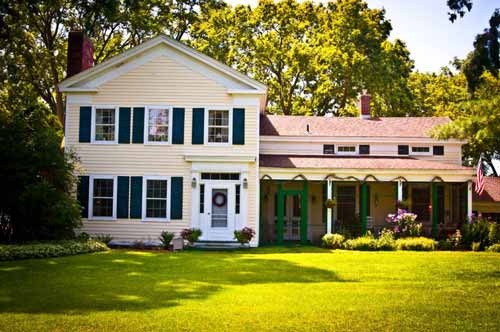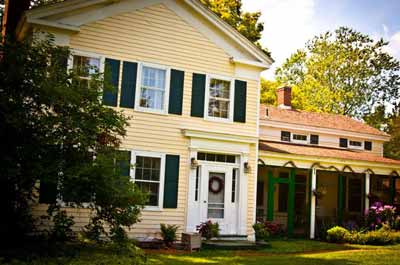|
The house
was built during the 1800's logging boom in Michigan. During that period
Saginaw sawmills processed about 5 BILLION board feet of lumber. As a
result, the house is built with probably 4 times more wood than an equivalent
house today. (For example the walls are sheathed with one inch planking
under the 1/2" weatherboard siding.)






|
|
Applewood
Farm was named after our old home in central Michigan. We do not live
there any more but it was a wonderful place to raise our four boys.
Some new owners are caring for it, fixing it up and making it there
own. We are sure they love it as much as we did. We will always treasure
living there. Here is our story about it:
This is a vernacular Greek Revival built right around 1860 at the start
of the Civil War by John Ure. John was the son of Andrew Ure who moved
here with his family in 1833. This is believed to be the third house
the Ures built on the property. The farm grew to about 250 acres in
it's heyday and included all of what is known today as Immerman Park.
Andrew Ure & John Ure can be found in Saginaw history books as prominent
and active members of the early community.
At the time this house was built the Greek Revival era was almost over.
Greek Revival architecture was most popular roughly from the 1830s to
1860s During that period Grecian style buildings were very popular in
the Midwest but alsocan be found throughout the country. Greek Revival
is the first of the American Romantic revival styles.
Greek Revival elements are taken from a classic Greek Temple with columns
supporting a horizontal framework just below the lower edge of the roof.
The peaked ends of the roof are enclosed in a triangular pediment.
Other Greek Revival elements are the windows of the house which are
typically large and tall (six over six, double or triple hung) to resemble
the spaces between the columns. In some houses these windows extend
all the way to the floor. Second story windows are placed directly above
the first floor windows to continue the effect. Large panels and small
"frieze" windows just under the roofline, above the siding,
are reminiscent of the decorated entablature panels on the temples.
On houses without actual columns in front, pilasters (columns built
into the wall) can be found on each side of the main entrance and at
the corners of the building. At the main entrance, between the pilasters
and the door are tall narrow window sections which are also carried
over the top of the door. The entryway is designed to reflect the columns
and beam construction of the main building. These narrow windows around
the main entry were so popular they can still be found on many other
architecture styles in modern houses today. Finally, the overall size
and massing of the structure, with the entryway in the center, low peaked
roof and pediment, smaller chimneys, and general symmetry are all elements
of a Greek Revival house whether it is a large and ornate mansion or
a smaller country farmhouse.
Our home is too small to be a full Greek Revival structure. Instead
it is a vernacular (in the style of) Greek Revival. As was often the
case, the entryway is offset to one side, the columns are pilasters
built into the walls around the main entry and at the corners. This
allowed the rooms on the ground floor to be larger and more useful given
the overall footprint of the structure.
The main house was once larger that it is today. The kitchen wing in
the back was torn down and moved into the living room just after World
War 2. The parlor is now the living room. Inside the entryway, a wall
between the parlor and the entry hallway was removed to make for a much
larger living room. An addition was also added to one end of the structure
to include an office and garage (now converted to a quilting
studio). The addition was done very well and matches up with the
original architecture seamlessly.
The old place stills has most of the original windows, hardware, doors,
floors, siding. etc. The floors are wide plank tongue & groove pine.
Most of the doors & windows have their original hardware and much
of the original glass is intact (bubbles, waves and all). In the lower
wing section of the house, the attic area sheltered the hired hands
on the farm. There was a small rear stairway that led to the kitchen
so the hired hands did not have to pass through the formal part of the
house. The barn next door was a very large structure which connected
to many of the out buildings so that once you were in the barn on a
cold winter day you could tend to most of the animals without going
outside. Local folklore is that the window glass was made at a nearby
smith shop and the local Souix had a summer fishing camp just up the
river in sight of the house.
The Ure house was built in the height of the Saginaw lumber boom. The
pine siding in the house is a solid 1/2 inch thick, not tapered clapboard
and is nearly knot free. The inside of the exterior walls are sheathed
in one inch thick by eight or ten inch wide planks, ten to twelve feet
long under the plaster. The ten by twelve inch timbers in the basement
still show the marks of the hand tools from the craftsman who shaped
the pockets into them to hold the joists over 150 years ago. If any
of this wood is cut today to make repairs the smell of fresh pine fills
the air as if the the trees were cut just last year.
It was a wonderful journey
and blessing to be the caretakers of such a home.
Kent & Beth Ferrier
|









